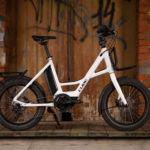D
Deleted member 4366
Guest
Ebike motors have a maximum efficiency of around 80%, but that only happens at one particular RPM. A figure of around 70% would be more realistic considering the the range of RPM actually used. There's another loss of 5% for the controller/wiring, and say 5% transmission lost by the time the power reaches the back wheel, so something 60% of the battery energy gets converted into motive power. Add that to your equations and then you can see why it doesn't make much sense for a 100kg guy to use a GTech in a hilly area unless he wants to do a lot of work.
I have a turbo trainer with a wattmeter on it. 100w at the back wheel, where it's measured, is equivalent to steady pedalling that most reasonably fit people can sustain for an hour - maybe 60w if you're not fit.
200w for an hour is a bit of a work-out. I would think that regular cyclists could achieve that if they had the right mind-set.
You need about 250w to sustain 15mph on the flat without any wind on an upright bike (MTB).
That means that unless you want to put in some effort, you'll be draining your battery at about 250watts (150/.60), which would give a range of about 30 miles at 15 mph on the flat (500Wh battery)
If you only went 10 mph, your 100w would be enough to power the bike, so your battery would last forever. In reality, I would say that most people cycle their ebikes in that 10 mph to 15 mph range, so we can say that they would get a battery range between 30 miles and infinity depending on how fast they go.
Now you bring in hills and you could half that range, which means somewhere between 15 miles and half of infinity (which is still infinity).
Next, you can introduce the variable of pedal effort. Someone that likes to pedal hard might average 200w, so at 15 mph his battery would go down at 83W, which would give him a range of 90 miles, or 45 miles with hills. Of course, it depends how many hills. You have to use the figures in the above post to calculated exactly.
A few charges back, I did 190 miles on one charge. I could have gone a lot further. The next charge took me about 15 miles. Same bike, same rider, different speed and different pedal effort.
When buying a bike, the only thing you need to consider regarding the range is the size of the battery. The bigger the battery, the further you'll go. The rest is down to you. There's no magic formula or ingredient X in any bike that will change any of the above except anything that reduces air resistance, rolling resistance or weight.
I have a turbo trainer with a wattmeter on it. 100w at the back wheel, where it's measured, is equivalent to steady pedalling that most reasonably fit people can sustain for an hour - maybe 60w if you're not fit.
200w for an hour is a bit of a work-out. I would think that regular cyclists could achieve that if they had the right mind-set.
You need about 250w to sustain 15mph on the flat without any wind on an upright bike (MTB).
That means that unless you want to put in some effort, you'll be draining your battery at about 250watts (150/.60), which would give a range of about 30 miles at 15 mph on the flat (500Wh battery)
If you only went 10 mph, your 100w would be enough to power the bike, so your battery would last forever. In reality, I would say that most people cycle their ebikes in that 10 mph to 15 mph range, so we can say that they would get a battery range between 30 miles and infinity depending on how fast they go.
Now you bring in hills and you could half that range, which means somewhere between 15 miles and half of infinity (which is still infinity).
Next, you can introduce the variable of pedal effort. Someone that likes to pedal hard might average 200w, so at 15 mph his battery would go down at 83W, which would give him a range of 90 miles, or 45 miles with hills. Of course, it depends how many hills. You have to use the figures in the above post to calculated exactly.
A few charges back, I did 190 miles on one charge. I could have gone a lot further. The next charge took me about 15 miles. Same bike, same rider, different speed and different pedal effort.
When buying a bike, the only thing you need to consider regarding the range is the size of the battery. The bigger the battery, the further you'll go. The rest is down to you. There's no magic formula or ingredient X in any bike that will change any of the above except anything that reduces air resistance, rolling resistance or weight.







